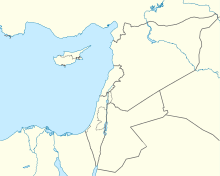| Siege of Tripoli | |||||||||
|---|---|---|---|---|---|---|---|---|---|
| Part of the Crusades | |||||||||
 Fakhr al-Mulk ibn Ammar submitting to Bertrand of Toulouse, 1842 painting by Charles-Alexandre Debacq | |||||||||
| |||||||||
| Belligerents | |||||||||
|
|
Banu Ammar emirate of Tripoli Seljuk Empire Fatimid Caliphate (from 1108) | ||||||||
| Commanders and leaders | |||||||||
|
Raymond IV of Toulouse (DOW) William II of Cerdanya (WIA) Bertrand of Toulouse Baldwin I of Jerusalem Baldwin II of Edessa Tancred of Galilee |
Fakhr al-Mulk ibn Ammar Sharaf ad-Dawla ibn Abi al-Tayyib (from 1108) | ||||||||
| Strength | |||||||||
|
Unknown number of Crusaders Large Genoese fleet | Unknown | ||||||||
| Casualties and losses | |||||||||
| Unknown | Unknown | ||||||||
Location within Lebanon | |||||||||
The siege of Tripoli lasted from 1102 until 12 July 1109. It took place on the site of the present day Lebanese city of Tripoli, in the aftermath of the First Crusade. It led to the establishment of the fourth crusader state, the County of Tripoli.

